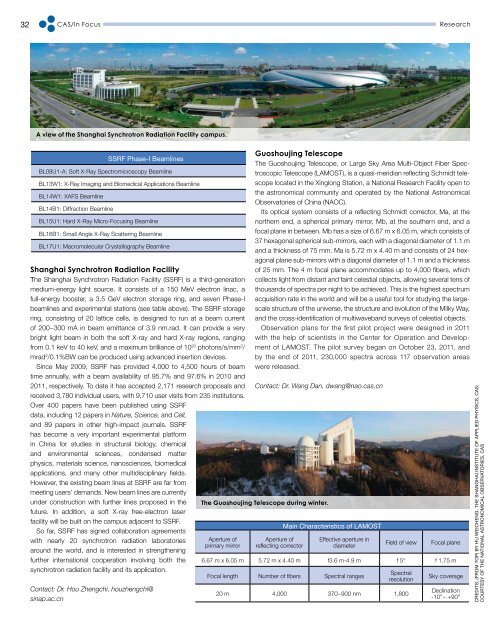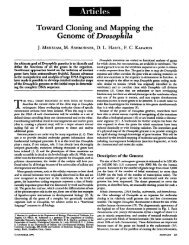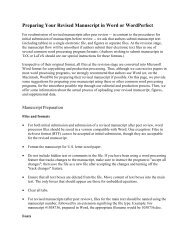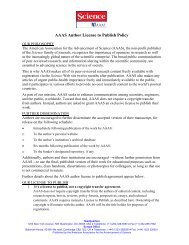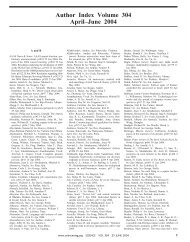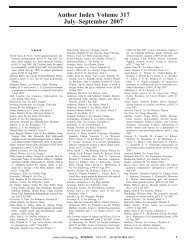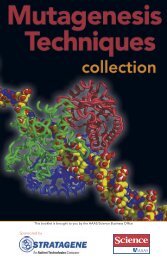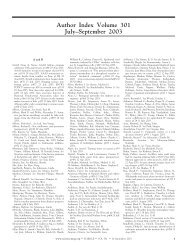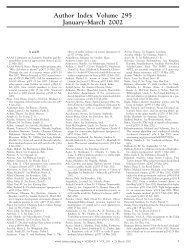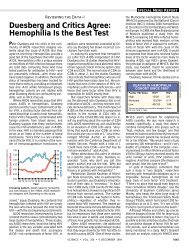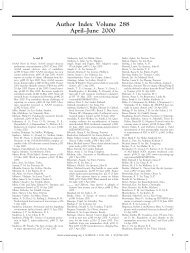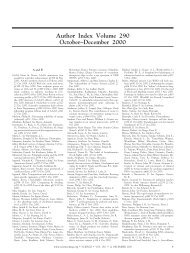Chinese Academy of Sciences (PDF) - low res version
Chinese Academy of Sciences (PDF) - low res version
Chinese Academy of Sciences (PDF) - low res version
You also want an ePaper? Increase the reach of your titles
YUMPU automatically turns print PDFs into web optimized ePapers that Google loves.
32<br />
CAS/In Focus<br />
A view <strong>of</strong> the Shanghai Synchrotron Radiation Facility campus.<br />
SSRF Phase-I Beamlines<br />
BL08U1-A: S<strong>of</strong>t X-Ray Spectromicroscopy Beamline<br />
BL13W1: X-Ray Imaging and Biomedical Applications Beamline<br />
BL14W1: XAFS Beamline<br />
BL14B1: Diffraction Beamline<br />
BL15U1: Hard X-Ray Micro-Focusing Beamline<br />
BL16B1: Small Angle X-Ray Scattering Beamline<br />
BL17U1: Macromolecular Crystallography Beamline<br />
Shanghai Synchrotron Radiation Facility<br />
The Shanghai Synchrotron Radiation Facility (SSRF) is a third-generation<br />
medium-energy light source. It consists <strong>of</strong> a 150 MeV electron linac, a<br />
full-energy booster, a 3.5 GeV electron storage ring, and seven Phase-I<br />
beamlines and experimental stations (see table above). The SSRF storage<br />
ring, consisting <strong>of</strong> 20 lattice cells, is designed to run at a beam current<br />
<strong>of</strong> 200~300 mA in beam emittance <strong>of</strong> 3.9 nm.rad. It can provide a very<br />
bright light beam in both the s<strong>of</strong>t X-ray and hard X-ray regions, ranging<br />
from 0.1 keV to 40 keV, and a maximum brilliance <strong>of</strong> 10 20 photons/s/mm 2 /<br />
mrad 2 /0.1%BW can be produced using advanced insertion devices.<br />
Since May 2009, SSRF has provided 4,000 to 4,500 hours <strong>of</strong> beam<br />
time annually, with a beam availability <strong>of</strong> 95.7% and 97.6% in 2010 and<br />
2011, <strong>res</strong>pectively. To date it has accepted 2,171 <strong>res</strong>earch proposals and<br />
received 3,780 individual users, with 9,710 user visits from 235 institutions.<br />
Over 400 papers have been published using SSRF<br />
data, including 12 papers in Nature, Science, and Cell,<br />
and 89 papers in other high-impact journals. SSRF<br />
has become a very important experimental platform<br />
in China for studies in structural biology, chemical<br />
and environmental sciences, condensed matter<br />
physics, materials science, nanosciences, biomedical<br />
applications, and many other multidisciplinary fields.<br />
However, the existing beam lines at SSRF are far from<br />
meeting users’ demands. New beam lines are currently<br />
under construction with further lines proposed in the<br />
future. In addition, a s<strong>of</strong>t X-ray free-electron laser<br />
facility will be built on the campus adjacent to SSRF.<br />
So far, SSRF has signed collaboration agreements<br />
with nearly 20 synchrotron radiation laboratories<br />
around the world, and is inte<strong>res</strong>ted in strengthening<br />
further international cooperation involving both the<br />
synchrotron radiation facility and its application.<br />
Contact: Dr. Hou Zhengchi, houzhengchi@<br />
sinap.ac.cn<br />
The Guoshoujing Telescope during winter.<br />
Aperture <strong>of</strong><br />
primary mirror<br />
Aperture <strong>of</strong><br />
reflecting corrector<br />
Main Characteristics <strong>of</strong> LAMOST<br />
Effective aperture in<br />
diameter<br />
Research<br />
Guoshoujing Telescope<br />
The Guoshoujing Telescope, or Large Sky Area Multi-Object Fiber Spectroscopic<br />
Telescope (LAMOST), is a quasi-meridian reflecting Schmidt telescope<br />
located in the Xinglong Station, a National Research Facility open to<br />
the astronomical community and operated by the National Astronomical<br />
Observatories <strong>of</strong> China (NAOC).<br />
Its optical system consists <strong>of</strong> a reflecting Schmidt corrector, Ma, at the<br />
northern end, a spherical primary mirror, Mb, at the southern end, and a<br />
focal plane in between. Mb has a size <strong>of</strong> 6.67 m x 6.05 m, which consists <strong>of</strong><br />
37 hexagonal spherical sub-mirrors, each with a diagonal diameter <strong>of</strong> 1.1 m<br />
and a thickness <strong>of</strong> 75 mm. Ma is 5.72 m x 4.40 m and consists <strong>of</strong> 24 hexagonal<br />
plane sub-mirrors with a diagonal diameter <strong>of</strong> 1.1 m and a thickness<br />
<strong>of</strong> 25 mm. The 4 m focal plane accommodates up to 4,000 fibers, which<br />
collects light from distant and faint celestial objects, al<strong>low</strong>ing several tens <strong>of</strong><br />
thousands <strong>of</strong> spectra per night to be achieved. This is the highest spectrum<br />
acquisition rate in the world and will be a useful tool for studying the largescale<br />
structure <strong>of</strong> the universe, the structure and evolution <strong>of</strong> the Milky Way,<br />
and the cross-identification <strong>of</strong> multiwaveband surveys <strong>of</strong> celestial objects.<br />
Observation plans for the first pilot project were designed in 2011<br />
with the help <strong>of</strong> scientists in the Center for Operation and Development<br />
<strong>of</strong> LAMOST. The pilot survey began on October 23, 2011, and<br />
by the end <strong>of</strong> 2011, 230,000 spectra across 117 observation areas<br />
were released.<br />
Contact: Dr. Wang Dan, dwang@nao.cas.cn<br />
Field <strong>of</strong> view Focal plane<br />
6.67 m x 6.05 m 5.72 m x 4.40 m f3.6 m-4.9 m f 5° f 1.75 m<br />
Focal length Number <strong>of</strong> fibers Spectral ranges<br />
Spectral<br />
<strong>res</strong>olution<br />
20 m 4,000 370~900 nm 1,800<br />
Sky coverage<br />
Declination<br />
-10°~ +90°<br />
CREDITS: (FROM TOP) BY HU WEICHENG, THE SHANGHAI INSTITUTE OF APPLIED PHYSICS, CAS;<br />
COURTESY OF THE NATIONAL ASTRONOMICAL OBSERVATORIES, CAS


